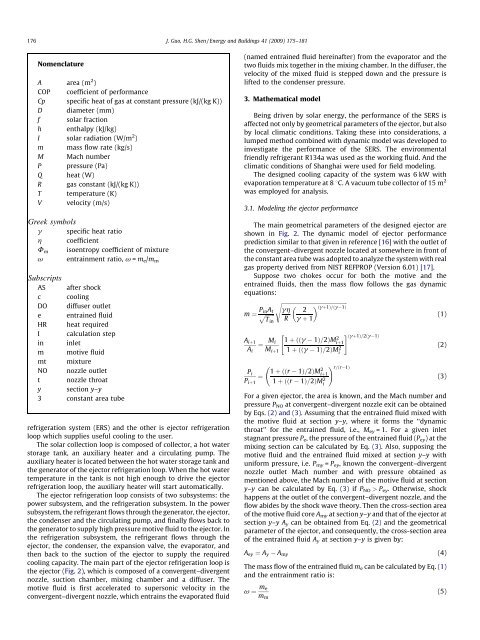Modeling solar-driven ejector refrigeration system offering air ...
Modeling solar-driven ejector refrigeration system offering air ...
Modeling solar-driven ejector refrigeration system offering air ...
Create successful ePaper yourself
Turn your PDF publications into a flip-book with our unique Google optimized e-Paper software.
176J. Guo, H.G. Shen / Energy and Buildings 41 (2009) 175–181NomenclatureA area (m 2 )COP coefficient of performanceCp specific heat of gas at constant pressure (kJ/(kg K))D diameter (mm)f <strong>solar</strong> fractionh enthalpy (kJ/kg)I <strong>solar</strong> radiation (W/m 2 )m mass flow rate (kg/s)M Mach numberP pressure (Pa)Q heat (W)R gas constant (kJ/(kg K))T temperature (K)V velocity (m/s)Greek symbolsg specific heat ratioh coefficientF m isoentropy coefficient of mixturev entrainment ratio, v = m e /m mSubscriptsAS after shockc coolingDO diffuser outlete entrained fluidHR heat requiredI calculation stepin inletm motive fluidmt mixtureNO nozzle outlett nozzle throaty section y–y3 constant area tube<strong>refrigeration</strong> <strong>system</strong> (ERS) and the other is <strong>ejector</strong> <strong>refrigeration</strong>loop which supplies useful cooling to the user.The <strong>solar</strong> collection loop is composed of collector, a hot waterstorage tank, an auxiliary heater and a circulating pump. Theauxiliary heater is located between the hot water storage tank andthe generator of the <strong>ejector</strong> <strong>refrigeration</strong> loop. When the hot watertemperature in the tank is not high enough to drive the <strong>ejector</strong><strong>refrigeration</strong> loop, the auxiliary heater will start automatically.The <strong>ejector</strong> <strong>refrigeration</strong> loop consists of two sub<strong>system</strong>s: thepower sub<strong>system</strong>, and the <strong>refrigeration</strong> sub<strong>system</strong>. In the powersub<strong>system</strong>, the refrigerant flows through the generator, the <strong>ejector</strong>,the condenser and the circulating pump, and finally flows back tothe generator to supply high pressure motive fluid to the <strong>ejector</strong>. Inthe <strong>refrigeration</strong> sub<strong>system</strong>, the refrigerant flows through the<strong>ejector</strong>, the condenser, the expansion valve, the evaporator, andthen back to the suction of the <strong>ejector</strong> to supply the requiredcooling capacity. The main part of the <strong>ejector</strong> <strong>refrigeration</strong> loop isthe <strong>ejector</strong> (Fig. 2), which is composed of a convergent–divergentnozzle, suction chamber, mixing chamber and a diffuser. Themotive fluid is first accelerated to supersonic velocity in theconvergent–divergent nozzle, which entrains the evaporated fluid(named entrained fluid hereinafter) from the evaporator and thetwo fluids mix together in the mixing chamber. In the diffuser, thevelocity of the mixed fluid is stepped down and the pressure islifted to the condenser pressure.3. Mathematical modelBeing <strong>driven</strong> by <strong>solar</strong> energy, the performance of the SERS isaffected not only by geometrical parameters of the <strong>ejector</strong>, but alsoby local climatic conditions. Taking these into considerations, alumped method combined with dynamic model was developed toinvestigate the performance of the SERS. The environmentalfriendly refrigerant R134a was used as the working fluid. And theclimatic conditions of Shanghai were used for field modeling.The designed cooling capacity of the <strong>system</strong> was 6 kW withevaporation temperature at 8 8C. A vacuum tube collector of 15 m 2was employed for analysis.3.1. <strong>Modeling</strong> the <strong>ejector</strong> performanceThe main geometrical parameters of the designed <strong>ejector</strong> areshown in Fig. 2. The dynamic model of <strong>ejector</strong> performanceprediction similar to that given in reference [16] with the outlet ofthe convergent–divergent nozzle located at somewhere in front ofthe constant area tube was adopted to analyze the <strong>system</strong> with realgas property derived from NIST REFPROP (Version 6.01) [17].Suppose two chokes occur for both the motive and theentrained fluids, then the mass flow follows the gas dynamicequations:sffiffiffiffiffiffiffiffiffiffiffiffiffiffiffiffiffiffiffiffiffiffiffiffiffiffiffiffiffiffiffiffiffiffiffiffiffiffiffiffiffiffiffiffiffiffiffim ¼ P inA t gh 2 ðgþ1Þ=ðg 1Þpffiffiffiffiffiffi(1)R g þ 1A iþ1A iT in" # ðgþ1Þ=2ðg¼ M i1 þððg 1Þ=2ÞMiþ12 1Þ(2)M iþ1 1 þððg 1Þ=2ÞMi2P iP iþ1¼ 1 þððr 1Þ=2ÞM2 iþ11 þððr 1Þ=2ÞM 2 i! r=ðr 1Þ(3)For a given <strong>ejector</strong>, the area is known, and the Mach number andpressure P NO at convergent–divergent nozzle exit can be obtainedby Eqs. (2) and (3). Assuming that the entrained fluid mixed withthe motive fluid at section y–y, where it forms the ‘‘dynamicthroat’’ for the entrained fluid, i.e., M ey = 1. For a given inletstagnant pressure P e , the pressure of the entrained fluid (P ey ) at themixing section can be calculated by Eq. (3). Also, supposing themotive fluid and the entrained fluid mixed at section y–y withuniform pressure, i.e. P my = P ey , known the convergent–divergentnozzle outlet Mach number and with pressure obtained asmentioned above, the Mach number of the motive fluid at sectiony–y can be calculated by Eq. (3) if P NO > P ey . Otherwise, shockhappens at the outlet of the convergent–divergent nozzle, and theflow abides by the shock wave theory. Then the cross-section areaof the motive fluid core A my at section y–y and that of the <strong>ejector</strong> atsection y–y A y can be obtained from Eq. (2) and the geometricalparameter of the <strong>ejector</strong>, and consequently, the cross-section areaof the entrained fluid A y at section y–y is given by:A ey ¼ A y A my (4)The mass flow of the entrained fluid m e can be calculated by Eq. (1)and the entrainment ratio is:v ¼ m em m(5)
















